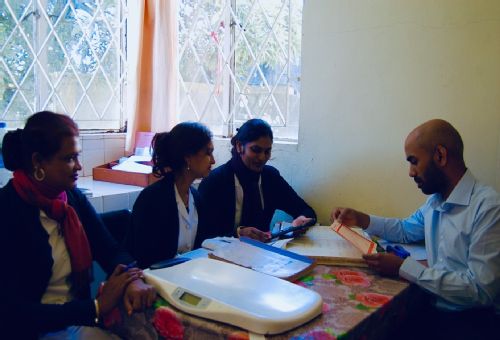Child malnutrition monitoring in Mauritius transformed with mobile technology
- Child malnutrition can be more accurately and quickly monitored in Mauritius if growth monitoring clinics use mobile-based data collection forms – new research
- Crucial data on children’s nutritional status can be collected and processed by central government in hours, rather than the months it currently takes with traditional paper forms
- Healthcare workers in north of the country found mobile-based data collection forms practical to use, with each assessment taking 69 seconds – potentially reducing overall workload
- Child growth monitoring using mobile devices revealed a substantially higher burden of child malnutrition than official government estimates based on their traditional paper-based system
Child malnutrition in Mauritius, and across Sub-Saharan Africa, could be monitored more accurately and quickly, thanks to simple mobile-based data collection forms, according to new research by the University of Warwick, UK.
The researchers demonstrated that mobile technology allows nurses to collect accurate data on children’s health in local clinics across Mauritius, and then send it to the government to be processed in near real-time, on the same day – rather than the months it currently takes to centrally collate and process information with traditional paper forms.
Senior author Dr Rishi Caleyachetty, Assistant Professor from Warwick Medical School, developed the use of mobile-based data collection forms and mobile devices for child nutrition surveillance.

The mobile-based data collection form closely mirrors the paper form currently used by healthcare staff to collect routine data from child growth monitoring clinics in Mauritius.
The forms record data on children aged 0-5, including information such as their height, weight, sex, age, and the district they live in.
The pilot implementation of the mobile-based data collection took place over a period of 18 days in nine primary care clinics across two districts in North Mauritius.
The results, published in the BMJ Global Health indicated healthcare staff found the mobile-based data collection form was usable, had the potential to reduce their workload and reduce data transmission time.
Healthcare staff used the mobile-based data collection form to assess 565 children visiting the clinic. The assessments revealed that 5.4% of them were underweight and 4.4% were overweight. Both estimates were dramatically higher than the official national and district-level estimates, which are consistently below 1%.
Dr Rishi Caleyachetty commented: "With childhood malnutrition linked to ill health including the risk of developing type 2 diabetes, as well as educational achievement and productivity later on in life, it is critical we develop new tools to make it more accurate and quicker to understand the nutrition situation in countries to the level of towns and villages.
“Mobile devices are now so widespread across Sub Saharan Africa that it seems to be an ideal platform to support improved child nutrition monitoring.
"In this study, our goal was to develop and pilot a mobile-based data collection form for a child growth monitoring program which would work in challenging contexts in Sub Saharan Africa, but also provide accurate enough estimates to support national policy development and local programme planning.
"My ultimate hope is that Ministries of Health in Sub Saharan Africa including Mauritius use mobile and wireless technology, to improve their child nutrition surveillance systems which will contribute ultimately to the prevention of control of child malnutrition.”
The mobile-based forms can be filled in by healthcare workers while the mobile device is offline — which is vitally important in more remote areas with minimal wireless infrastructure — and the data can be sent instantly to the Ministry of Health and Quality of Life, once connected to the internet or 3G/4G network.
Ten healthcare staff were asked to take part in the research, the majority of whom reported that it was easier to use the mobile-based data collection form than paper, and those who found it a challenge felt they could soon become accustomed to using it.
Over half of staff said that the mobile-based data collection forms would decrease their overall workload during a month, because they won’t have to keep monthly records in books.
Healthcare staff also said it was quicker to use the mobile-based data collection form, compared with paper forms: the average time it took to collect data from a child was 69 seconds.
This is the first time that such a process for child nutrition surveillance, using mobile-based data collection forms has been piloted in Mauritius.
Whilst the Republic of Mauritius has a child (0-5 years) nutrition surveillance system, country estimates are absent from WHO country statistics and Global Nutrition Reports.
Undernutrition (stunting or wasting) during early childhood can have irreversible consequences on the child's growth leading to an increased risk of morbidity and mortality. Overnutrition during early childhood can increase the risk of developing type 2 diabetes. Africa is one of the regions globally that has the greatest share of all forms of malnutrition. In 2018, 39% of children under five living in Africa are stunted, 28% are wasted and 24% are overweight.
However, child nutrition information in Sub Saharan Africa is typically out of date, and the use of routine data for nutrition monitoring is extremely limited. The mobile-based data collection form offers a solution by enabling health workers to collect routine data on children’s nutrition status and then transmit that data for analysis on the same day – rather than the many months it currently takes the Ministry of Health to collate and process information with traditional paper forms.
6 December 2019
For further information contact:
Luke Walton, International Press Manager
+44 (0) 7823 362 150
--------------------------------------------
Click here to read full paper in BMJ Global Health.
